MARCH KEY FIGURES
 |  | % change Dec qtr 05 to Mar qtr 06 | % change Mar qtr 05 to Mar qtr 06 |
|
| GDP (Chain volume measure) |  |  |
 | Trend | 0.6 | 2.8 |
 | Seasonally adjusted | 0.9 | 3.1 |
| Final consumption expenditure (Chain volume measure) |  |  |
 | Trend | 0.7 | 2.6 |
 | Seasonally adjusted | 0.6 | 2.7 |
| Gross fixed capital formation (Chain volume measure) |  |  |
 | Trend | 1.6 | 9.9 |
 | Seasonally adjusted | 1.3 | 12.0 |
| GDP chain price index |  |  |
 | Original | 0.9 | 4.9 |
| Terms of trade |  |  |
 | Seasonally adjusted | -0.9 | 10.7 |
| Real net national disposable income |  |  |
 | Trend | 0.7 | 4.4 |
 | Seasonally adjusted | 1.1 | 5.3 |
|
GDP growth rates, Chain volume measure, quarterly change
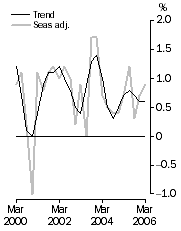
| Contributions to GDP growth, Expenditure - Seasonally adjusted

|
MARCH KEY POINTS
VOLUME GDP
- In trend terms, GDP increased by 0.6% in the March quarter. GDP per capita grew by 0.3%, GDP per hour worked in the market sector increased by 1.2% and Real net national disposable income grew by 0.7%.
- In seasonally adjusted terms, GDP increased by 0.9% in the March quarter. Non-farm GDP grew by 0.8% and the Terms of trade fell by 0.9%.
EXPENDITURE ON GDP
- In seasonally adjusted terms, the increase in expenditure on GDP was a result of positive contributions from Household consumption (+0.6 percentage points), Private business investment (+0.2 percentage points) and Public investment (+0.2 percentage points) offset by a negative contribution from Investment in dwellings (-0.2 percentage points). Growth in Net exports and Changes in inventories had no significant impact on GDP growth.
INDUSTRY GROSS VALUE ADDED
- In trend terms, both Mining and Manufacturing detracted 0.1 percentage points from GDP growth. Agriculture, forestry and fishing, Communication services, Finance and insurance, Property and business services and Health and community services each contributed 0.1 percentage points to GDP growth.
NOTES
FORTHCOMING ISSUES
| ISSUE (QUARTER) | Release Date |
| June 2006 | 6 September 2006 |
| September 2006 | 6 December 2006 |
REVISIONS IN THIS ISSUE
Revisions have been made to a number of aggregates. Their net effect on the December quarter 2005 estimate of seasonally adjusted gross domestic product (GDP) (in volume terms) has been to increase quarterly growth by 0.2 percentage points. The causes of the revisions are of two types:
- the quarterly revisions due to the incorporation of more up-to-date source data, which have been significant for Gross fixed capital formation on Machinery and equipment and Non-dwelling construction
- seasonal reanalysis on a number of series, in particular components of household and government final consumption expenditure, and the Electricity, gas and water supply industry.
CHANGES IN THE NEXT ISSUE
With the release of the June quarter 2006 issue on 6th September 2006, the current Lotus 1-2-3 .wks spreadsheets will be discontinued and replaced with Excel .xls spreadsheets. For more information, see the Recent Releases section.
SATELLITE ACCOUNT RELEASES
The ABS has recently released satellite account publications for Information and Communication Technology and Tourism. For more information, see the Recent Releases section.
INQUIRIES
From the March quarter 2006 issue of Australian National Accounts: National Income, Expenditure and Product there will be a change to the contact officer arrangements. Inquiries can now be referred to the National Information Referral Service on 1300 135 070 or Terry Rawnsley on Canberra (02) 6252 6711.
MAIN FEATURES EXPENDITURE CHAIN VOLUME MEASURES
 |  |  | Trend | Seasonally adjusted |  |
 |  |  | Quarterly % change Dec 05 to Mar 06 | Annual % change Mar 05 to Mar 06 | % points contribution to growth in GDP Dec 05 to Mar 06 | Quarterly % change Dec 05 to Mar 06 | Annual % change Mar 05 to Mar 06 | % points contribution to growth in GDP Dec 05 to Mar 06 |  |
|  |
| Final consumption expenditure |  |  |  |  |  |  |  |
 | General government | 0.4 | 2.0 | 0.1 | -0.3 | 1.9 | - |  |
 | Households | 0.7 | 2.8 | 0.4 | 0.9 | 2.9 | 0.6 |  |
| Gross fixed capital formation |  |  |  |  |  |  |  |
 | Private |  |  |  |  |  |  |  |
 |  | Dwellings | -2.9 | -4.5 | -0.2 | -2.5 | -2.3 | -0.2 |  |
 |  | Business investment | 3.2 | 18.8 | 0.5 | 1.1 | 20.4 | 0.2 |  |
 |  | Ownership transfer costs | 1.6 | 2.0 | - | 7.3 | 6.5 | 0.1 |  |
 | Public | 2.4 | 4.6 | 0.1 | 5.9 | 7.6 | 0.2 |  |
| Changes in inventories |  |  |  |  |  |  |  |
 | Private non-farm | . . | . . | - | . . | . . | - |  |
 | Farm and public authority | . . | . . | - | . . | . . | - |  |
| Gross national expenditure | 0.9 | 4.3 | 1.0 | 0.8 | 4.6 | 0.8 |  |
| Exports of goods and services | 0.3 | 1.2 | - | 0.5 | 1.8 | 0.1 |  |
| Imports of goods and services | 1.5 | 6.4 | -0.3 | 0.4 | 6.5 | -0.1 |  |
| Statistical discrepancy (E) | . . | . . | - | . . | . . | - |  |
| Gross domestic product | 0.6 | 2.8 | 0.6 | 0.9 | 3.1 | 0.9 |  |
|  |
| . . not applicable |
| - nil or rounded to zero (including null cells) |
MARCH QUARTER
Summary Comments
Final Consumption Expenditure
- Household final consumption expenditure grew by 0.7% in trend terms (0.9% seasonally adjusted) during the March quarter, driven by growth in retail expenditure. This growth was below the growth rates experienced during 2003-04 when trend growth averaged 1.6% per quarter.
Gross fixed capital formation (GFCF)
- Private business investment increased by 3.2% in trend terms (1.1% seasonally adjusted) during the March quarter. The seasonally adjusted growth was due to Machinery and equipment (up 1.5%) and New building (up 0.6%) offset by falling New engineering construction (down 3.4%). Dwellings fell by 2.9% in trend terms (2.5% seasonally adjusted).
Changes in inventories
- Total inventories increased by $726 million in trend terms, which followed a similar rise of $764 million in the December quarter. As a result, changes in inventories had virtually no effect on the growth of GDP(E) during the March quarter.
Exports and imports of goods and services
- In trend terms, Exports of goods and services increased 0.3% (0.5 seasonally adjusted) in the March quarter. Exports of services increased by 3.6% seasonally adjusted, which was driven mainly by a 5.7% increase in Travel services. This offset a seasonally adjusted fall of 0.4% in the Exports of goods.
- Imports of goods and services increased by 1.5% in trend terms in the March quarter, compared to a 1.8% increase in the previous period.
MAIN FEATURES PRODUCTION CHAIN VOLUME MEASURES
 | Trend | Seasonally adjusted |  |
 | Quarterly % change Dec 05 to Mar 06 | Annual % change Mar 05 to Mar 06 | % points contribution to growth in GDP Dec 05 to Mar 06 | Quarterly % change Dec 05 to Mar 06 | Annual % change Mar 05 to Mar 06 | % points contribution to growth in GDP Dec 05 to Mar 06 |  |
|  |
| Agriculture, forestry and fishing | 2.4 | 1.1 | 0.1 | 2.1 | 3.1 | 0.1 |  |
| Mining | -1.7 | -2.9 | -0.1 | -3.1 | -2.4 | -0.1 |  |
| Manufacturing | -1.0 | -0.8 | -0.1 | -1.1 | -0.9 | -0.1 |  |
| Electricity, gas and water supply | 1.3 | 1.6 | - | 2.7 | 1.9 | 0.1 |  |
| Construction | 0.6 | 7.5 | - | -0.3 | 7.6 | - |  |
| Wholesale trade | 0.8 | 3.4 | - | 1.1 | 4.5 | 0.1 |  |
| Retail trade | 0.7 | 0.9 | - | 1.8 | 1.0 | 0.1 |  |
| Accommodation, cafes and restaurants | -0.5 | -2.6 | - | -0.3 | -2.7 | - |  |
| Transport and storage | 0.9 | 1.9 | - | 2.3 | 2.2 | 0.1 |  |
| Communication services | 2.5 | 9.2 | 0.1 | 2.5 | 9.6 | 0.1 |  |
| Finance and insurance | 1.7 | 5.8 | 0.1 | 2.5 | 6.4 | 0.2 |  |
| Property and business services | 0.9 | 3.0 | 0.1 | 0.3 | 3.3 | - |  |
| Government administration and defence | 0.6 | 2.4 | - | 1.0 | 2.6 | - |  |
| Education | 0.3 | 1.2 | - | 0.3 | 1.2 | - |  |
| Health and community services | 0.8 | 3.9 | 0.1 | -0.6 | 3.8 | - |  |
| Cultural and recreational services | 0.6 | 9.3 | - | -2.1 | 8.5 | - |  |
| Personal and other services | -0.5 | -0.2 | - | -0.2 | -0.4 | - |  |
| Ownership of dwellings | 0.9 | 3.9 | 0.1 | 1.0 | 3.9 | 0.1 |  |
| Taxes less subsidies on products | - | 0.1 | - | 0.6 | 0.5 | 0.1 |  |
| Statistical discrepancy (P) | . . | . . | 0.1 | . . | . . | 0.4 |  |
| Gross domestic product | 0.6 | 2.8 | 0.6 | 0.9 | 3.1 | 0.9 |  |
|  |
| . . not applicable |
| - nil or rounded to zero (including null cells) |
MARCH QUARTER
Summary Comments
Agriculture, Forestry and Fishing
- The trend estimate increased by 2.4% and the seasonally adjusted estimate by 2.1%. The main contributions came from increased cattle slaughterings and cereal production, the latter due to wet weather in the December quarter causing a late wheat harvest in March quarter.
Mining
- The trend estimate fell by 1.7% and the seasonally adjusted estimate by 3.1%. This fall was mainly a result of decreased crude oil production due to the impact of cyclones off the Western Australian coast.
Manufacturing
- The trend estimate fell by 1.0% (1.1% seasonally adjusted). This seasonally adjusted fall was mainly due to a 5.2% fall in the manufacture of machinery and equipment.
Construction
- The trend estimate increased by 0.6%. The seasonally adjusted estimate fell 0.3% ending the increases over the past six quarters. This was mainly due to falls in residential building activity as well as in private engineering construction.
Transport and storage
- Increased 0.9% in trend terms and 2.3% in seasonally adjusted terms. Seasonally adjusted, Road and Rail transport grew significantly, by 4.9% and 7.0% respectively. The latter is associated with increased freight for the large grain crops that were harvested in December and March quarters.
Wholesale and Retail Trade
- These industries increased by 0.8% and 0.7% respectively in trend terms while their seasonally adjusted estimates increased by 1.1% and 1.8%.
MAIN FEATURES INCOME AT CURRENT PRICES
 |  | Trend | Seasonally adjusted |  |
 |  | Quarterly % change Dec 05 to Mar 06 | Annual % change Mar 05 to Mar 06 | % points contribution to growth in GDP Dec 05 to Mar 06 | Quarterly % change Dec 05 to Mar 06 | Annual % change Mar 05 to Mar 06 | % points contribution to growth in GDP Dec 05 to Mar 06 |  |
|  |
| Compensation of employees | 1.5 | 7.1 | 0.7 | 1.3 | 7.0 | 0.6 |  |
| Gross operating surplus |  |  |  |  |  |  |  |
 | Private | 1.0 | 11.3 | 0.2 | 0.2 | 12.1 | - |  |
 | Other | 1.9 | 7.1 | 0.3 | 2.0 | 7.0 | 0.3 |  |
| Gross mixed income | 0.8 | 2.6 | 0.1 | 1.1 | 3.0 | 0.1 |  |
| Taxes less subsidies on production and imports | 0.6 | 2.2 | 0.1 | 0.9 | 2.5 | 0.1 |  |
| Statistical discrepancy (I) | . . | . . | - | . . | . . | -0.4 |  |
| Gross domestic product | 1.3 | 7.1 | 1.3 | 0.7 | 7.3 | 0.7 |  |
|  |
| . . not applicable |
| - nil or rounded to zero (including null cells) |
MARCH QUARTER
Summary Comments
Compensation of employees(COE)
- Compensation of employees represented 53.6% of total factor income in the March quarter. The trend increase of 1.5% in the March quarter reflected a rise of 1.2% in average earnings and a 0.3% rise in the number of wage and salary earners. Seasonally adjusted, compensation of employees grew by 1.3%. Average earnings increased by 0.8%, while the number of wage and salary earners increased by 0.5%.
Wages(a) share of total factor income: Trend
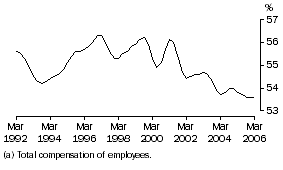
Gross operating surplus (GOS)
- Gross operating surplus of corporations represented 27.1% of total factor income in the March quarter. The March quarter saw a 1.4% increase in trend GOS (1.0% in seasonally adjusted terms). While this was somewhat lower than the growth over the past four quarters, GOS remained at historically high levels.
Profit(a) share of total factor income: Trend

MAIN FEATURES STATE FINAL DEMAND CHAIN VOLUME MEASURES
 | Trend | Seasonally adjusted |  |
 | Quarterly % change Dec 05 to Mar 06 | Annual % change Mar 05 to Mar 06 | % points contribution to growth in DFD Dec 05 to Mar 06 | Quarterly % change Dec 05 to Mar 06 | Annual % change Mar 05 to Mar 06 | % points contribution to growth in DFD Dec 05 to Mar 06 |  |
|  |
| New South Wales | 0.3 | 1.9 | 0.1 | - | 2.1 | - |  |
| Victoria | 0.4 | 3.4 | 0.1 | 0.1 | 4.0 | - |  |
| Queensland | 1.9 | 7.7 | 0.4 | 3.3 | 9.2 | 0.6 |  |
| South Australia | 0.4 | 3.0 | - | 0.7 | 3.7 | - |  |
| Western Australia | 2.7 | 11.1 | 0.3 | 1.7 | 10.6 | 0.2 |  |
| Tasmania | 0.9 | 5.2 | - | 0.8 | 5.9 | - |  |
| Northern Territory | 0.6 | 5.0 | - | 2.7 | 6.5 | - |  |
| Australian Capital Territory | 0.5 | 3.2 | - | -2.0 | 2.4 | -0.1 |  |
| Australia (DFD)(a) | 0.9 | 4.5 | 0.9 | 0.8 | 5.0 | 0.8 |  |
|  |
| - nil or rounded to zero (including null cells) |
| (a) Domestic final demand. |
MARCH QUARTER
Summary Comments
State Final Demand
- In trend terms, growth in the March quarter was strongest in Western Australia (up 2.7%). In seasonally adjusted terms, Queensland (up 3.3%) showed the strongest growth with the major contributor being public gross fixed capital formation. Only the Australian Capital Territory recorded a fall in seasonally adjusted terms (down 2%), due predominantly to a fall in public gross fixed capital formation.
Household final consumption expenditure
- In trend terms, all states experienced growth, ranging from 1.1% in the Australian Capital Territory to 0.4% in South Australia and the Northern Territory. Seasonally adjusted growth was recorded in all states, with Victoria the strongest (up 1.3%).
Government final consumption expenditure
- Trend growth in the March quarter was strongest in Tasmania (up 1.2%), while the lowest was in Western Australia (down 0.5%). Seasonally adjusted growth occurred in Queensland and Tasmania (up 2.2% and 1.1% respectively), while all other states recorded falls.
Private gross fixed capital formation
- In trend terms, the strongest growth was recorded in Western Australia (up 6.5%). Trend growth was weakest in New South Wales (down 1.6%). In seasonally adjusted terms the strongest growth was recorded in the Northern Territory (up 9.5%), with the weakest growth in the Australian Capital Territory (down 3.9%).
- In seasonally adjusted terms, investment in machinery and equipment was mixed, with the Australian Capital Territory recording the largest fall (down 17.4%), while growth was strongest in the Northern Territory (up 31.4%). The strongest growth in Non-dwelling construction occurred in South Australia (up 8.5%), with the weakest growth in Victoria (down 9.2%). Strong dwelling investment growth was recorded in the Australian Capital Territory (up 7.7%), while Victoria had the largest fall (down 8.0%).
Public gross fixed capital formation
- Trend growth was strongest in New South Wales (up 4.2%), while the largest fall was recorded in the Northern Territory (down 5.5%). In seasonally adjusted terms, strong growth was recorded in Queensland (up 14.9%), with a large fall occurring in the Australian Capital Territory (down 13.8%).
ANALYSIS AND COMMENTS
GROWTH RATES IN GDP
Following the fall in GDP (in seasonally adjusted volume terms) in December quarter 2000, there have been 21 consecutive quarters of growth, averaging around 0.8% per quarter.
Percentage changes, Chain volume measures
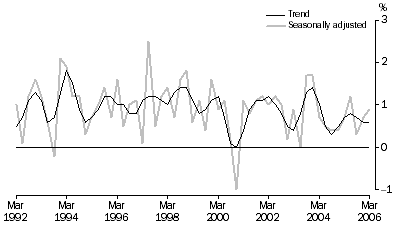
The growth (in trend volume terms) over the past four quarters was driven by Household final consumption expenditure (up 2.8%), Private investment in machinery and equipment (up 22.2%) and New engineering construction (up 22.4%). The 2.8% growth in Household final consumption expenditure has been weaker than the growth experienced during 2003 and 2004, (5.1% and 4.6% respectively).
Offsetting the growth during the past four quarters was a strong rise in Imports of goods and services (up 6.4%) and a fall in Dwelling investment (down 4.5%).
On the production side, the strongest industries (in trend volume terms) over the past four quarters have been Construction (7.5%) and Finance and insurance (5.8%). Detracting from growth were falls in Mining (2.9%), Manufacturing (0.8%) and Accommodation, cafes and restaurants (2.6%).
REAL GROSS DOMESTIC INCOME
The real purchasing power of income generated by domestic production can be affected by changes in import and export prices. Real gross domestic income adjusts the chain volume measure of GDP by the Terms of trade. The graph below provides a comparison of quarterly movements in trend GDP (volume measure) and Real gross domestic income. During the March quarter, trend Real gross domestic income increased by 0.8%, compared to the increase in the trend volume measure of GDP of 0.6%, reflecting a 1.2% improvement in the trend Terms of trade. Trend and seasonally adjusted estimates of real gross domestic income are shown in tables 1 and 2.
Percentage changes, Trend
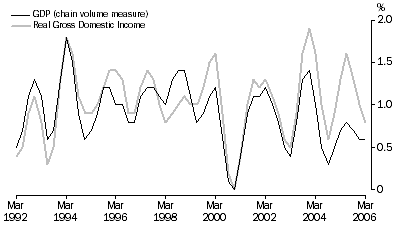
TERMS OF TRADE
The Terms of trade represent the relationship between the prices of exports and imports. An increase (decrease) in the Terms of trade reflects export prices increasing (decreasing) at a faster rate than import prices. The strong growth in the Terms of trade from March quarter 2003 (up 32.2%) reflected a 20.4% growth in export prices and a 7.3% fall in import prices over the period. The March quarter 2006 saw a 1.2% increase in trend terms to a record high (122.9) in the Terms of trade index. Seasonally adjusted Terms of trade fell 0.9% on the December quarter 2005. This was the first seasonally adjusted fall since June 2002.
Trend, (2003-04 = 100)
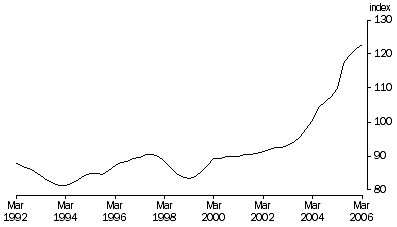
REAL NET NATIONAL DISPOSABLE INCOME
A broader measure of change in national economic well-being is Real net national disposable income. This measure adjusts the volume measure of GDP for the Terms of trade effect, Real net incomes from overseas and Consumption of fixed capital (see Glossary for definition). The graph below provides a comparison of quarterly movements in trend GDP (volume measure) and Real net national disposable income. During the March quarter, trend Real net national disposable income increased by 0.7%, down from a 0.9% increase in the previous quarter.
Percentage changes, Trend
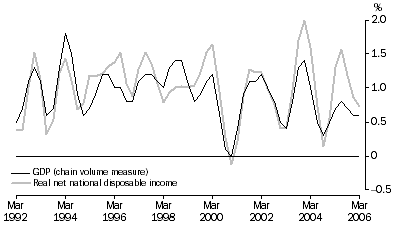
HOUSEHOLD SAVING RATIO
In both trend (-2.2%) and seasonally adjusted (-2.6%) terms the Household saving ratio was negative in March quarter 2006, implying that household consumption was greater than household disposable income.
Household saving ratio, Current prices

Household savings cannot be directly measured by the National Accounts. Rather it is calculated as a residual item by deducting Household final consumption expenditure from Household gross disposable income. As the difference between the two aggregates is relatively small, caution should be exercised in interpreting the Household saving ratio in recent years, because major components of household income and expenditure may be subject to significant revisions. The impact of these revisions on the saving ratio can cause changes in the direction of the trend.
COMPENSATION OF EMPLOYEES
In March quarter 2006, seasonally adjusted Compensation of employees grew by 1.3%, while the seasonally adjusted number of employees recorded in the Labour Force survey grew by 0.5%. Thus, Average compensation per employee increased by 0.8%. This followed growth of 1.5% in the previous two quarters Through the year growth in average compensation per employee was 4.7% compared to 4.0% growth over the same period in the total hourly rates of pay, excluding bonuses as published in Labour Price Index, Australia (cat. no. 6345.0). It should be noted that the conceptual bases for the two wage measures are different.
PRIVATE NON-FARM INVENTORIES TO TOTAL SALES RATIO
The relationship between Private non-farm inventories and Total sales provides some insight into the health of the economy. An increase in the ratio would indicate there has been, in relative terms, a build up of inventories or a fall in sales, or both.
In trend current price terms, the book value of Private non-farm inventories increased by $1,851 million (1.7%) in March quarter 2006, while total sales rose by $2,857 million (1.9%). Consequently, as sales have risen at a faster rate than inventories, the ratio decreased from 0.735 in the December quarter 2005 to 0.733 in March quarter 2006.
Trend, Current prices

IMPORTS TO DOMESTIC SALES
The Imports to domestic sales ratio, trended and at current prices, increased from 0.351 in the December quarter 2005 to 0.356 in the March quarter. This reflected a rise of 2.9% in Imports of goods accompanied by a 1.7% rise in Domestic sales.
Trend, Current prices
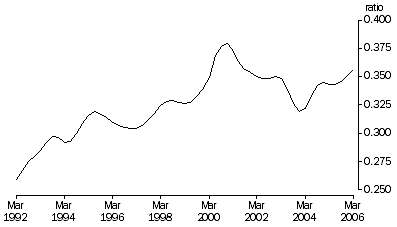
RELIABILITY OF CONTEMPORARY TREND ESTIMATES
Trend estimates are used throughout this publication as an alternative approach to the analysis of movements in time series data. Further details regarding the procedures used to estimate the trend series are described in the Explanatory Notes (paragraphs 13 - 17) and in Information Paper: A Guide to Interpreting Time Series - Monitoring Trends, 2003 (cat. no. 1349.0) released in August 2003.
Potential revisions to trend estimates can be indicated by showing the effects of particular changes in seasonally adjusted estimates that might occur in the next quarter. The table below shows the trend estimates for the last ten quarters and the values to which they would be revised if the given movements in seasonally adjusted GDP actually occurred in June quarter 2006. Seasonally adjusted growth of 0.2% is required in June quarter 2006 to maintain, in June quarter 2006, the trend growth of 0.6% currently estimated for the March quarter 2006.
Percentage change in GDP Chain volume measure |
|  |
 |  |  |  | Trend estimate if seasonally adjusted GDP changes by the following amounts in June qtr 2006 |  |
 |  | Seasonally adjusted GDP as published in table 2 | Trend GDP as published in table 1 | Grows by 1.0% | No change | Falls by 1.0% |  |
|  |
| 2003 |  |  |  |  |  |  |
 | December | 1.7 | 1.4 | 1.4 | 1.4 | 1.4 |  |
| 2004 |  |  |  |  |  |  |
 | March | 0.7 | 1.0 | 1.0 | 1.0 | 1.0 |  |
 | June | 0.5 | 0.5 | 0.5 | 0.5 | 0.5 |  |
 | September | 0.4 | 0.3 | 0.3 | 0.3 | 0.3 |  |
 | December | 0.4 | 0.5 | 0.5 | 0.5 | 0.5 |  |
| 2005 |  |  |  |  |  |  |
 | March | 0.7 | 0.7 | 0.7 | 0.7 | 0.7 |  |
 | June | 1.2 | 0.8 | 0.8 | 0.8 | 0.8 |  |
 | September | 0.3 | 0.7 | 0.7 | 0.7 | 0.8 |  |
 | December | 0.7 | 0.6 | 0.7 | 0.6 | 0.5 |  |
| 2006 |  |  |  |  |  |  |
 | March | 0.9 | 0.6 | 0.8 | 0.5 | 0.3 |  |
|  |
IMPACT OF CYCLONES ON NATIONAL ACCOUNTS
On 20 March 2006, North Queensland was hit by category-5 Tropical Cyclone Larry, devastating a wide area around Innisfail. Significant damage was inflicted on infrastructure, residential and commercial buildings, and the region's agriculture industry.
North-west Western Australia was impacted by two cyclones in the March quarter - Tropical Cyclone Clare, which crossed the Pilbara coast west of Dampier on 9 January, and Tropical Cyclone Glenda, which crossed the coast near Onslow on 30 March.
Many national accounts aggregates will be affected by the economic activity and lost production as a result of the cyclones.
- Cyclone Larry will result in a drop in economic activity in agriculture and related transport, manufacturing and wholesale activities. There will be a negative effect on tourism, but this is likely to be offset by the economic benefits of an influx of reconstruction workers. Construction will receive a boost through the repair and reconstruction work.
- Most of these effects were limited for the Western Australian cyclones, as they were less intense than Cyclone Larry and did not affect heavily populated areas. However, there was a negative effect on crude oil production and an interruption to exports of mining production. These were evident in the March quarter national accounts and balance of payments estimates and are likely to affect the June quarter as well.
Overall, the effects are expected to feed through from the regular data sources used to compile the accounts, so no adjustments are considered necessary. The effects are unlikely to be identifiable at the national level.
RECENT RELEASES
INFORMATION AND COMMUNICATION TECHNOLOGY SATELLITE ACCOUNT (CAT. NO. 5259.0)
On 7 March the ABS released the first official satellite account on Information and Communication Technology (ICT) for Australia. It measures the contribution of ICT to the Australian economy in 2002-03, in particular, the contribution of ICT to key macro-economic variables such as gross domestic product (GDP).
Publication tables also include details of Australian production of various ICT products, as well as related imports, exports, household consumption, business spending and investment expenditure. Together, these data form an integrated set of statistics on ICT products within the framework of the international standards, System of National Accounts 1993 (SNA93).
The publication contains a complete description of data sources and concepts used (frameworks, classifications etc.), as well as a discussion of key methodological issues.
TOURISM SATELLITE ACCOUNT (CAT. NO. 5249.0)
On 6 April the ABS released its official Tourism Satellite Account (TSA) for Australia. It measures the contribution of Tourism to the Australian economy in 2004-05. The emphasis in the TSA is on the measurement of tourism consumption and the size of the tourism industry, including its contribution to gross domestic product (GDP).
Within the TSA publication, a number of key economic measures associated with tourism are able to be identified. These include: tourism gross value added; tourism GDP; the tourism share of the value-added of major tourism related industries (such as accommodation, restaurants and cafes, air and water transportation); total household and business tourism consumption by type of products; consumption by overseas visitors; and employment generated by tourism. Together, these data form an integrated set of statistics on tourism products within the framework of the international standards, System of National Accounts 1993 (SNA93).
The publication contains a description of tourism concepts, data sources and methods used to compile tourism estimates for the update year, as well as a glossary of definitions of tourism related national accounting terms. It also provides a tourism products and industries concordance with Australian and New Zealand Standard Product Classification (ANZSPC) and Australian and New Zealand Standard Industrial Classification (ANZSIC).
CHANGES TO SPREADSHEETS FOR THE QUARTERLY AUSTRALIAN NATIONAL ACCOUNTS
On 11 May the ABS released an Information Paper (cat. no. 5206.0.55.001) on proposed changes to the time series spreadsheets associated with the Australian National Accounts: National Income, Expenditure and Product (cat. no. 5206.0), resulting from the conversion of the current Lotus 1-2-3 .wks spreadsheets to Excel .xls format.
These changes are due to come into effect with the release of the June quarter 2006 issue of 5206.0 on 6 September 2006. From that date, the current Lotus 1-2-3 .wks spreadsheets will be discontinued.
A second edition of the Information Paper will be released on 9 June containing data from the March quarter 2006 release.
 Print Page
Print Page
 Print All
Print All